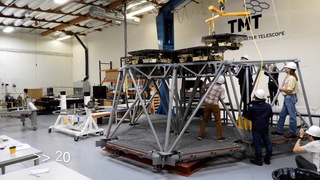Installation of TMT mirror segment prototype on the MSIT facility at TMT technical lab in California. This time-lapse video, recorded on February 11, 2020, shows the painstaking process of integrating a primary mirror segment into the TMT Multi-Segment Integration & Test (MSIT) facility. It shows the integration of the seventh and final segment -
Video credit: TMT international Observatory / Saeko S. Hayashi
View Video Page
TMT Reaches Major Milestone with Completion of Fully Populated Mirror Segment Prototypes at the Multi-Segment Integration & Test Facility (MSIT)
Pasadena, CA – The Multi-Segment Integration & Test (MSIT) facility at the TMT lab in Monrovia, California, is now fully populated with seven aluminum mirror segment prototypes. The final segment installation culminates a sequence of segment integration and installation cycles that have lasted several weeks, following months of preparation.
As part of the preparatory phase of this work, TMT opto-mechanical engineers integrated each of the seven segments with the Segment Support Assembly (SSA) and carried out careful alignment checks with the aid of advanced metrological equipment. The resulting assemblies, consisting of an SSA and its attached segment, were then carefully installed in sequence into MSIT.
During installation each segment assembly is transferred from a lifting crane onto the Segment Lifting Jack, which supports the segment and lowers it into position. Alignment is critical throughout this process, as the final position of an installed segment is only 2.5 mm away from its nearest neighbors. As such, the procedure requires great care and concentration from the team.
MSIT, with its full set of installed segments, is now ready to be used in numerous test and development activities that will further advance the work of the TMT Optics and Controls groups. This will include evaluations of the M1 Control System actuator and edge-sensor hardware, and tests for the Optics group to assess their ability to precisely position and measure the locations of the segments and associated hardware once installed. All these activities will lead to early detection of any issues, enable any needed design changes and ensure that the systems that are installed into the telescope on the summit are of the highest possible standard.
Chris Carter, TMT Telescope Controls Engineer, says: “This fully-populated test facility will help us further validate and advance the design of the primary mirror system by providing TMT with a full-scale test-bed with which the Controls and Optics groups can identify potential issues and test solutions. The prototype testing enabled by this facility is essential in order to gather critical performance data, and address technical risks at the earliest stage. MSIT helps our engineering teams meet and exceed their design goals and deliver the best possible system to the summit.”

The TMT Multi-Segment Integration & Test (MSIT) facility, fully populated with seven full-size aluminum segments, at the Monrovia laboratory, on February 11, 2020 - Fabricated by TMT-Japan, MSIT recreates a subset – approximately 1/70th - of the TMT primary mirror cell, and the segments it carries accurately recreate the unique hexagonal forms of the seven segments that will exist in the telescope in the same positions. Mirror segments in TMT are of 82 types – each one very slightly different – arranged in six identical sectors. MSIT contains segments from sectors D and E of the primary mirror.
Image Credit: TMT International Observatory, LLC

TMT engineers involved in the installation of the primary mirror segment assembly prototypes into the TMT Multi-Segment Integration & Test (MSIT) facility - Left to right: Bryan Smith (Quality Assurance and Testing Engineer), Alastair Heptonstall (Senior Opto-mechanical Engineer), Chris Carter (Telescope Controls Engineer), Alan Tubb (Associate Opto-mechanical Engineer), Ben Gallagher (M1 System Lead Engineer) and Nikhil Naik (Production Support Manager).
Image Credit: TMT International Observatory, LLC






